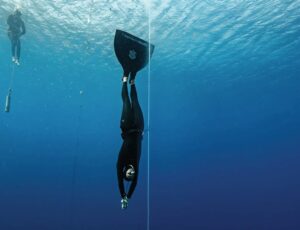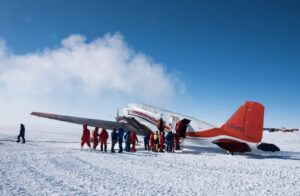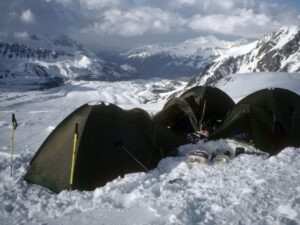Since the introduction of postage stamps in the 1830s, images of famous explorers and expeditions have often featured on these miniature artworks. Below, a small sampling of notable stamps.
In 2015, Canada Post issued three stamps to commemorate the ill-fated Franklin expedition of 1845. The timing coincided with Parks Canada’s groundbreaking discovery of the remains of HMS Erebus the year before. A year after the stamps came out, in 2016, Franklin’s other ship, HMS Terror, turned up in the same region. The Franklin expedition had long been commemorated in story and song, and the stamps illustrate its importance to the Canadian imagination.

HMS Erebus. Photo: Postage Stamp Guide
The 3-cent conquistador
In 1940, a series of U.S. three-cent stamps marked the 400th anniversary of the 1540 Coronado Expedition, led by conquistador Francisco Vazquez de Coronado. He sought the mythical Seven Cities of Gold, a popular 16th-century myth circulated by previous expeditions.
Coronado led a huge expedition of 400 Europeans, 2,000 native Mexicans, 4 Franciscan priests, and enslaved Native Americans and Africans. This semi-army left Mexico to wander through the southwestern United States.
While he didn’t find any mineral wealth, he did manage to be the first European to view the priceless scenery of the Colorado River and the Grand Canyon. The expedition ended on a sour note, with an unexpected war with the Tiwa people. He was eventually charged with war atrocities and fell into bankruptcy. Despite its unsavory history, the expedition has earned credit for mapping many of the Southwestern and Midwestern states.

Coronado expedition stamp. Photo: Smithsonian National Postal Museum

Spanish conquistador Francisco Vazquez de Coronado led a large expedition from Mexico to present-day Kansas. Photo: Shutterstock
Christmas stamps
A series of 2017 Australian stamps recall voyages of exploration to elusive Christmas Island in the 17th and 19th centuries.
In 1643, Captain William Mynors named Christmas Island, after sailing past it on December 25. While he did not set foot on land, his discovery led to the island’s inclusion on world navigational charts from 1666. Exactly 22 years later, William Dampier landed on the island and discovered many exotic species, which flourished in the island’s long isolation.
The following years passed uneventfully. Ships avoided anchoring offshore because of the dangerous cliffs. However, the 19th century changed the island’s destiny, as it fell under the covetous eyes of the British Empire.
Two 1887 voyages catapulted the remote island into the international spotlight. Captains John Maclear and Pelham Aldrich went ashore on separate occasions and unlocked more of its secrets.
Maclear found an anchorage in a bay which he called Flying Fish Cove. He collected samples of plants and animals and discovered the Christmas Island rat, which — somewhat ingloriously — was named after him.
Aldrich’s findings were even more impressive. He took rock samples to a lab in Edinburgh. It turned out that they were pure phosphate of lime, a valued fertilizer and anticaking agent. This prompted the British to annex the island in 1888.
The two captains also detailed their encounters with the iconic Christmas Island red crab, whose migrations nowadays attract thousands of visitors a year. The stamps portray Maclear and Aldrich in a nostalgic and vintage fashion.

Stamp commemorating Mynor’s voyage in 1643. Photo: Australian Post

Christmas Island’s John Maclear stamp. Photo: Australia Post

Christmas Island Pelham Aldrich Stamp. Photo: Australia Post

The crabs of Christmas Island enthralled the two explorers. Photo: Shutterstock
Lewis and Clark
The Lewis and Clark Expedition from 1803 to 1806 was one of the monumental journeys in the exploration of America. Captain Meriwether Lewis and Second Lieutenant William Clark ventured west to explore the new lands acquired after the Louisiana Purchase of 1803. These two, along with 45 men and their famed interpreter Sacagawea mapped vast swathes of this new territory.
They crossed the Continental Divide, discovered Montana, visited the Pacific Coast, and opened diplomatic relations with around 70 tribes. Their 140 maps featured impressive accuracy and detail. Their inventory of 178 plants and 122 animal species was one of the expedition’s greatest achievements.

A 1954 stamp of the Lewis and Clark Expedition. Photo: John Kropewnicki

The year 2004 marked the 200th anniversary of the Lewis and Clark Expedition. Photo: Shutterstock
Selling stamps to fund expeditions
From 1927 to 1935, the Sino-Swedish Expedition brought the world’s best scientists from China, Sweden, Denmark, Estonia, and Germany to study China’s vast northern regions. It was led by Swedish explorer Sven Hedin.
Their task: to investigate the history, geography, and meteorology of Xinjiang, Mongolia, and the Gobi Desert. The expedition had two sources of revenue: the patronage of Chiang Kai-shek and the sale of stamps.
The expedition discovered China’s wealth in such natural resources as oil, gold, iron, and coal. The team then went deeper into the desert, looking for potential opportunities for irrigation and proper roads from Beijing to Xinjiang. Hedin also figured out why the Lop Nor Lake tended to “wander”.
Some scholars believe that Sven and the expedition earned high government support not just out of enthusiasm for science but as a means of solidifying the power of Chiang Kai-shek’s nationalist party.

Sino Swedish expedition stamps. Photo: Sven Hedin Foundation

Sino-Swedish Expedition stamp. Photo: Worth Point
Amelia was a collector
Did you know that Amelia Earhart was an avid stamp collector? Not only did she appreciate the art of philately but she too used it to fund her expeditions. Her circumnavigation of the world by plane in 1937 was perhaps the greatest adventure of the century for a woman.
Earhart had already achieved a series of aviation firsts: first woman to fly across the Atlantic as a passenger, first to pilot a nonstop flight across the Atlantic. The World Flight of 1937 was to be her best and biggest journey, 47,000km in a twin-engine Lockheed Electra 10E, with navigator Fred Noonan accompanying her.
The expedition bore its weight in problems from the start. In the end, Earhart and Noonan vanished. Their fate is one of the great adventure mysteries. Today, Earhart is a cultural icon and a role model on how to remain resilient what the going gets tough.

A 1963 postcard of Amelia Earhart. Photo: Shutterstock

A 1963 stamp portrait of the famous aviatrix, Amelia Earhart. Photo: John Kropewnicki/Shutterstock
Kon-Tiki stamps
The 25th anniversary of the Kon-Tiki Expedition (1947) earned a stamp series in 1972. Norwegian explorer Thor Heyerdahl gained notoriety for his hypothesis that before Columbus, South Americans traveled to Polynesia. To strengthen his case, he drifted 7,000km with the currents on a balsa wood raft. Although the scientific community rejected Heyerdahl’s theories, his voyages and his many books continue to enthrall.

Kon-Tiki Expedition stamp. Photo: Philatelic Database

A stamp from Sao Tome and Principe, a tiny island nation off west-central Africa, shows Thor Heyerdahl and his famous raft, Kon-tiki. Photo: Shutterstock
Zeppelin to the Arctic
In 1931, a German airship rendezvoused with a Soviet icebreaker to exchange mail and test the Zeppelin’s ability to fly in the Arctic and to land on water. The Zeppelin carried 5,100kg of supplies, survey equipment, and a team of scientists from Germany, the Soviet Union, the United States, and Sweden.
Within three days of leaving Germany, it landed successfully on the sea off Franz Josef Land. This maiden polar flight covered 13,310km in 136 hours. After exchanging its goods with the icebreaker, it successfully returned home. The sale of postage stamps also financed the expedition. As with the other expeditions, they sold not the stamps themselves but an envelope mailed with these specific stamps to a donor’s address — a very personal souvenir.

Graf Zeppelin’s first polar flight. Photo: Stamp-Collecting-World

A Zeppelin in the Arctic. Photo: Olga Popova/Shutterstock
Shackleton and Co.
Earlier this year, a series of stamps honored a group of Irish Antarctic explorers for their roles in the Heroic Age of Polar Exploration. Among them, Tom Crean and Robert Forde of Scott’s Terra Nova Expedition, and Ernest Shackleton, who was also on the Terra Nova but who became uber-famous after leading his men 1,300km across the stormiest seas on earth in an open boat after his ship sank in the Antarctic.

Tom Crean. Photo: AN Post






